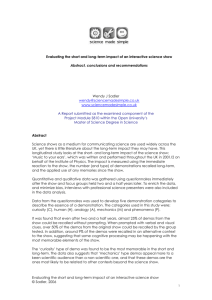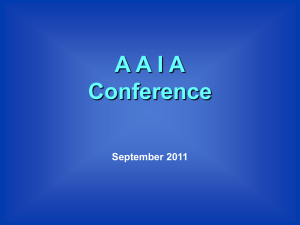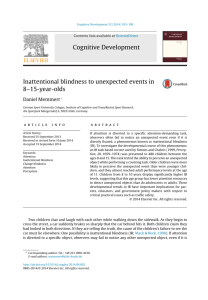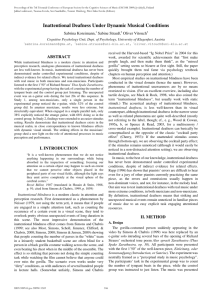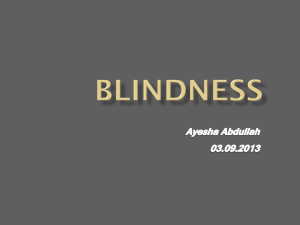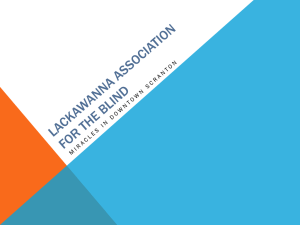PPT - UCI Cognitive Science Experiments
advertisement
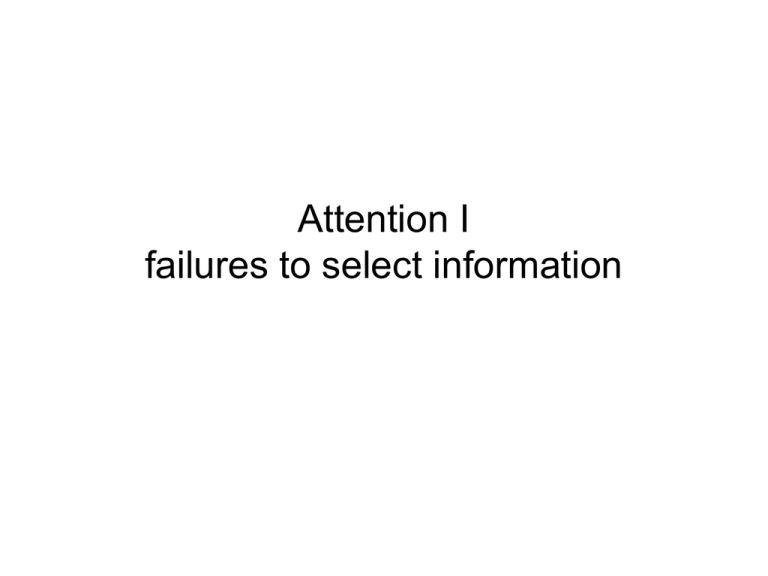
Attention I failures to select information What is attention? • How is the word used? • Examples: – something bright caught my attention – I didn’t see you, I was paying attention to the game – I struggled to pay attention to the lecture – I don’t remember even cleaning the table, I must not have been paying attention • Attention refers to many different kinds of mechanisms Attention Attention enhances some information and inhibits other information. The enhancement enables us to select some information for further processing The inhibition enables us to set some information aside. Attention and limits on information • We need attention to limit the amount of information that is processed • Why are there limits on the amount of information we can process? – limited sensory systems Eye tracking • Eye-tracking studies can tell us which information is attended to – Our eyes are drawn both by top-down information (e.g. a goal to find specific information) as well as bottom-up information (e.g. a flashing light) • Commercial intro on eye-tracking Eye tracking device eye movements during reading Eye tracking and Visual Attention Eye tracking and Visual Attention Painting by Giuseppe Arcimboldo. Earth. c.1570. Oil on wood. Private collection, Vienna, Austria. [Yarbus 1967] Improving layout with eye-tracking studies David Hockney’s photo collage might be a metaphor for the way we see scenes 1 photo = 1 gaze Attention and limits on information • Human information processing is massively parallel, up to a point where we have serial bottlenecks • Bottleneck: a restriction on the amount of information that can be processed at once forcing serial processing Inattentional Blindness • After bottleneck, it is the allocation of our attention that determines what is analyzed. • Often, we are unable to process information that is unattended. This can lead to inattentional blindness (related to change blindness) Do you notice the change? Some of these demos are from: Simons & Levin, 1997, TINS, 1, 261-267 Do you notice the change? Some of these demos are from: Simons & Levin, 1997, TINS, 1, 261-267 Do you notice the change? Some of these demos are from: Simons & Levin, 1997, TINS, 1, 261-267 Do you notice the change? Some of these demos are from: Simons & Levin, 1997, TINS, 1, 261-267 Other demos • Lots of demos: – http://viscog.beckman.uiuc.edu/djs_lab/demos.html – http://dualtask.org/Change_Blindness_Demo/ChangeBlindness.html Airplane demo Dinner demo Inattentional Blindness • Why is it hard to notice the change (initially)? • When motion detection is disrupted, it is very difficult to observe changes to unattended image locations • Brain makes reasonable assumption that things do not change unexpectedly (in the absence of motion cues). Demo of basketball players • Task: count the number of times the white team passes the ball to each other • Important to pay close attention to the white team • Demos at: • http://www.youtube.com/watch?v=wg96RSsrXk0&feature=watch_response http://viscog.beckman.uiuc.edu/flashmovie/15.php http://viscog.beckman.uiuc.edu/flashmovie/25.php Did you notice anything unusual? a) no b) yes (Simons & Chabris, Perception, 1999, 28, 1059 – 1074) (not) noticing person changes Demos from Dan Simons (University of Illinois): http://viscog.beckman.uiuc.edu/change/demolinks.shtml http://viscog.beckman.uiuc.edu/flashmovie/12.php http://viscog.beckman.uiuc.edu/flashmovie/10.php Another demo with gender change: http://www.youtube.com/watch?v=vBPG_OBgTWg see also letter task: http://www.dualtask.org/ Inattentional Blindness • Shows there are remarkable gaps in our perception • Human’s interpretation of the visual field is much sparser than the subjective experience of “seeing” suggests • Our visual system might be overwhelmed without change blindness -- in a real-world setting with many moving objects, it might make sense to “track” only a few objects Failures of Selection in Time When new information (even if only a small amount) arrives in a rapid stream, spending time processing it will cause you to miss some other incoming information, resulting in what are called failures of selection in time. Attentional Blink Demos: http://www.cs.kent.ac.uk/people/rpg/pc52/AB_Webscript/instr.html http://psych.hanover.edu/JavaTest/Cognition/Cognition/attentionalblink_instructions.html Sources of Limitation The attentional blink is a short period during which incoming information is not registered, similar in effect to the physical blanking out of visual information during the blink of an eye. Divided-attention studies demonstrate that performance is hampered when you have to attend to two separate sources of visual information or two separate visual events. In all these cases, the decrement in performance is referred to as dual-task interference.
